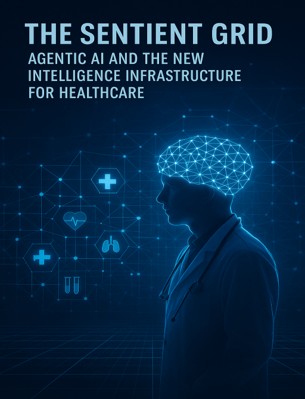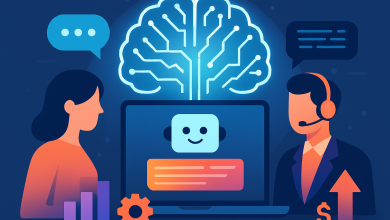
Healthcare organizations are seeking ways to modernize their intelligence infrastructure while managing the increasing complexity of care delivery. Agentic AI is a new generation of autonomous, goal-directed systems emerging as a key enabler of this transformation. These agents operate independently to perform specific tasks, while coordinating across teams, digital platforms, and clinical workflows.
The drive to bring these systems into healthcare mirrors what’s happening in other industries. In banking, financial services, and insurance, agentic AI is scaling quickly, with the global generative AI market expected to grow from $1.90 billion in 2025 to $13.57 billion by 2032, a 32.5% annual growth rate, according to Fortune Business Insights. Healthcare is beginning to follow a similar path, applying these capabilities to clinical and operational areas.
Unlike conventional AI tools that require direct human prompts, agentic AI agents can reason through scenarios, make decisions based on clinical goals, and execute actions within pre-defined guardrails. This operating model supports the creation of distributed intelligence across healthcare systems, integrating digital workflows into care delivery with minimal friction.
Applied Use Cases Across the Healthcare Value Chain
The most significant progress in agentic AI adoption is in operational and administrative processes where inefficiencies are most acute. For example, major health system contact centers use AI agents to triage patient queries, authenticate users, schedule appointments, and handle routine insurance inquiries, reducing wait times and freeing human agents to manage complex interactions.
In care management, agentic systems track chronic patients across care episodes, identify symptom anomalies from EHR data, and prompt patients through SMS or apps for medication adherence or lifestyle interventions. In scheduling operations, agents coordinate across providers, handle real-time changes, and integrate payer constraints into the scheduling flow.
At the point of care, ambient AI systems passively listen during virtual consults, transcribe conversations, summarize SOAP notes, and draft follow-up actions. In these scenarios, agents remove administrative burden from clinicians, enabling them to focus on patient engagement while maintaining oversight of all automated actions.
In supply chain operations, agentic AI is being deployed to manage demand sensing, distribution optimization, and cold chain integrity—critical areas highlighted during the COVID-19 vaccine distribution, where cold chain challenges led to significant vaccine wastage in various regions. By orchestrating multi-agent systems across logistics, demand forecasting, and supplier coordination, healthcare organizations and pharmaceutical firms are improving resiliency and reducing costly disruptions.
Core Technical Capabilities Underpinning Agentic AI
To function safely in healthcare environments, agentic AI systems require specific technical capabilities:
- Multimodal understanding: Integrates diverse inputs such as clinical notes, images, audio, and lab data to synthesize holistic insights.
- Contextual memory: Maintains longitudinal awareness across patient journeys, essential for managing chronic conditions where care spans months or years.
- Reasoning and goal orientation: Supports dynamic adaptation to clinical goals, such as avoiding readmissions or adjusting treatments as new data emerges.
- Tool use: Interfaces with APIs, EHR systems, and digital workflows to trigger actions and coordinate tasks across multiple platforms.
Designing for Trust, Interpretability, and Safety
Healthcare stakeholders will not adopt agentic systems at scale unless they can be trusted, controlled, and understood. Four principles are essential:
- Explainability: Agents must provide visibility into how recommendations were reached, referencing data sources and clinical guidelines.
- Traceability: Every action and decision must be logged and auditable, ensuring accountability in clinical workflows.
- Controllability: Clinicians maintain the ability to review, edit, or halt agent actions at any stage, ensuring that AI does not overstep into autonomous clinical decision-making.
- Bias mitigation: Continuous validation using demographically representative datasets and fairness monitoring is essential to avoid replicating or amplifying systemic biases.
Regulatory Oversight and Self-Governance Models
Global regulators are evolving frameworks to govern the deployment of agentic AI in healthcare. The FDA’s Digital Health Center of Excellence has introduced guidance for AI/ML-based software as a medical device (SaMD), with a focus on transparency, human oversight, and post-deployment performance monitoring.
In Europe, the EU AI Act classifies clinical AI systems as high-risk, requiring rigorous safety, robustness, and data governance compliance. These external standards are complemented by industry best practices like Good Machine Learning Practice (GMLP), which emphasize continuous validation, iterative testing, and real-world monitoring to account for the dynamic nature of agentic systems.
However, regulators alone cannot address the scale and complexity of agentic AI deployments. Leading healthcare organizations and technology partners are establishing internal governance functions, combining real-time performance dashboards, audit trails, and incident monitoring to ensure agents remain safe and reliable throughout their lifecycles.
Strategies for Responsible Adoption and Scale
Organizations deploying agentic AI successfully are prioritizing low-risk, high-volume workflows. For example, prior authorization adjudication processes, benefit verification inquiries, and claims processing are areas where agentic agents can safely execute tasks with clear rules and measurable outcomes.
By focusing on routine tasks first, healthcare systems can build internal confidence, establish feedback loops, and fine-tune agent performance before expanding to more sensitive clinical scenarios. Pilot programs include human-in-the-loop designs for more complex domains like radiology support or chronic disease management, ensuring clinicians maintain oversight. At the same time, agents handle data analysis, documentation, and preliminary pattern recognition.
Throughout these deployments, organizations are advised to take a pragmatic approach to ROI measurement, focusing not only on cost reductions but also on clinician productivity, patient experience improvements, and reductions in care delays. Metrics should include operational efficiencies, diagnostic turnaround times, readmission rates, and adherence to treatment protocols.
Implementation partners play a critical role in enabling these structured change programs offering data modernization services, secure cloud and edge infrastructure, and co-designed agentic workflows that align with clinical and operational goals.
Laying the Foundation for Scalable Intelligence
Agentic AI is already proving its value in operational domains that are routine, resource-intensive, and governed by clear parameters. By first anchoring deployments in these areas, organizations can create safe, reliable pathways toward broader use across clinical workflows. Success will depend on the technology and building the right data foundations, governance models, and clinician trust from the outset.
The future of healthcare intelligence will not be defined by AI alone, but by how well organizations design distributed systems that integrate agents, clinicians, and operational teams into a cohesive, accountable intelligence infrastructure that serves patients and providers.





